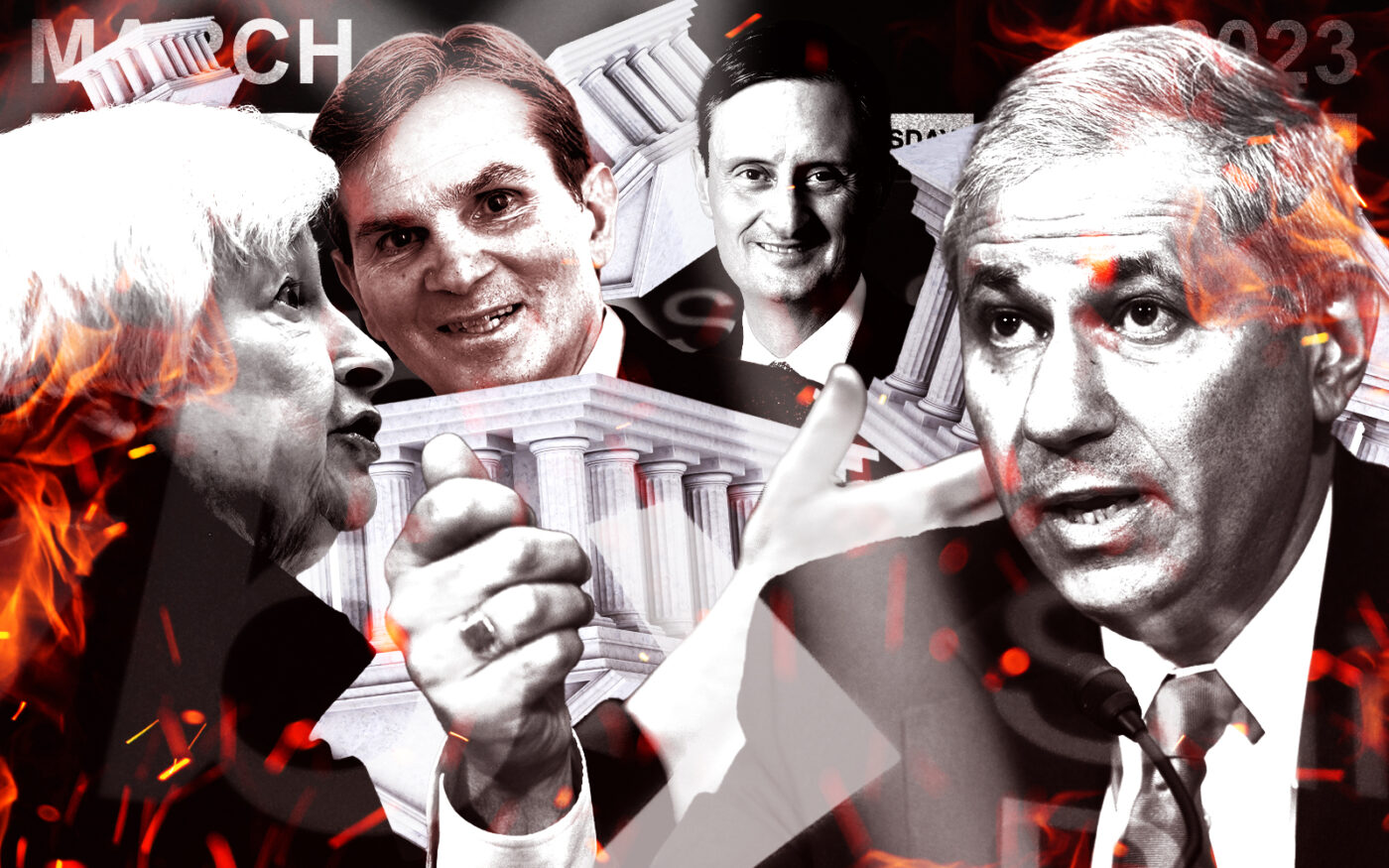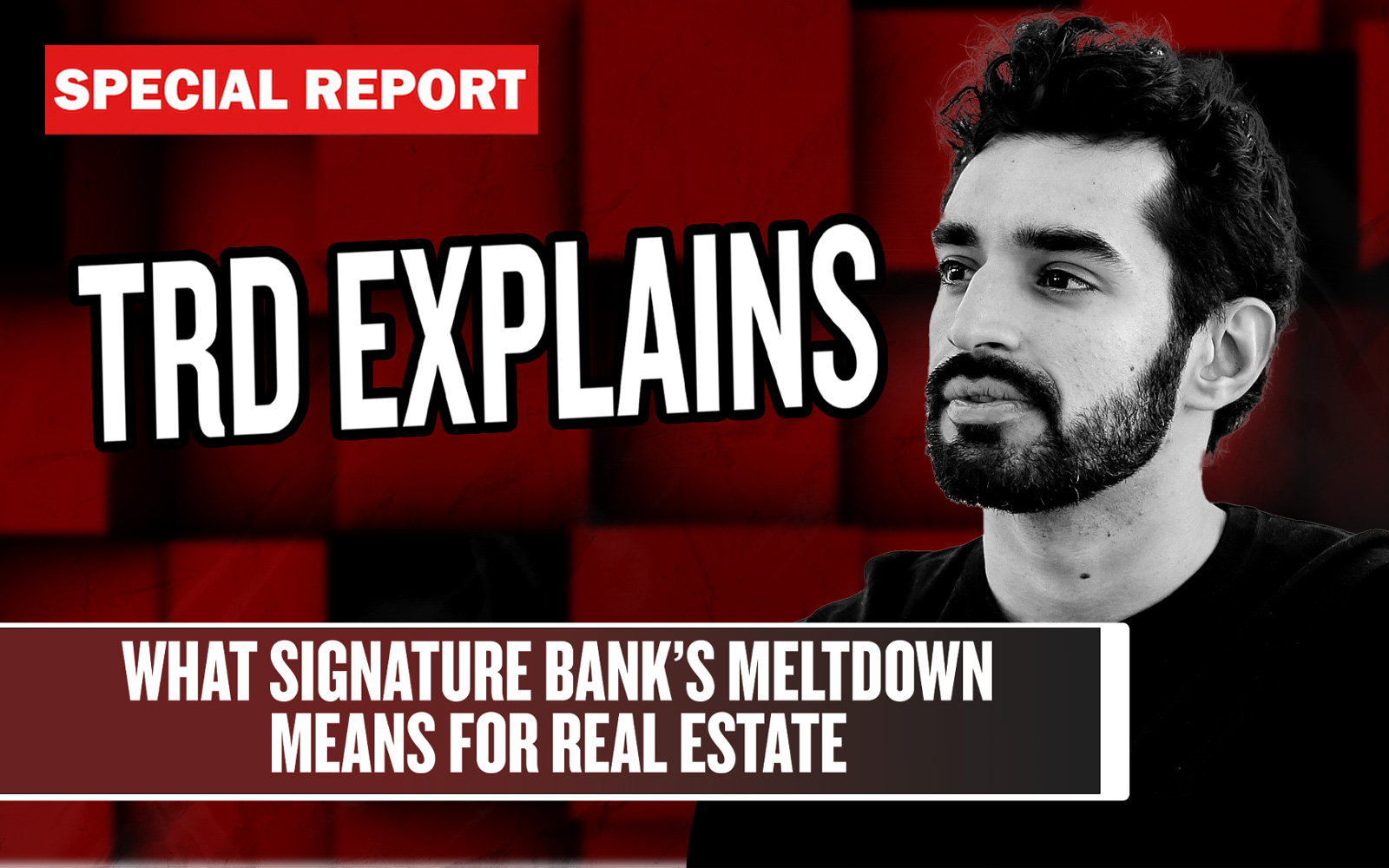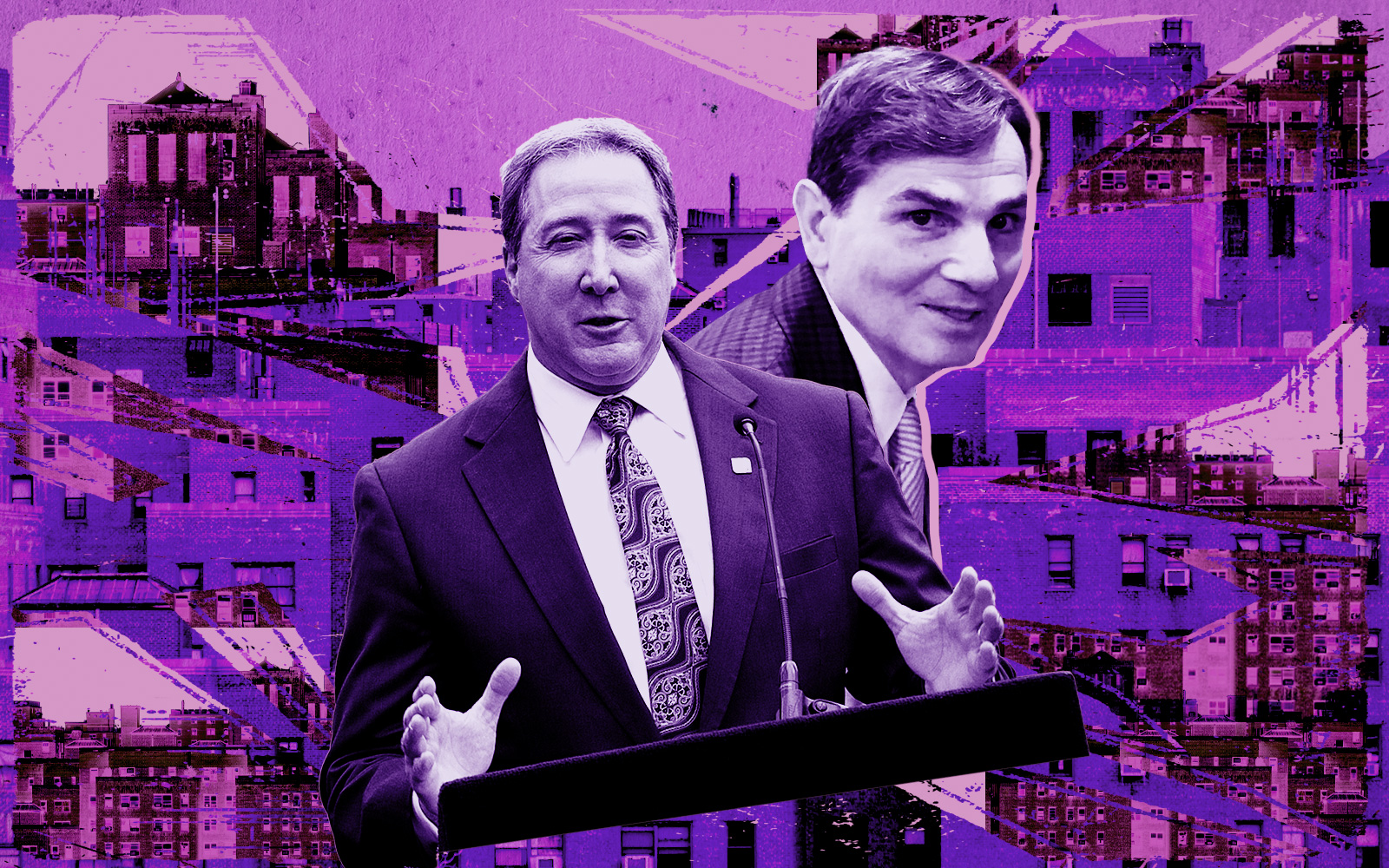Trending
Nine days in hell: Inside the lending crisis that rocked multifamily
Institutions collapsed, deals froze and fear took over. A look back at banking’s crucible

“How did you go bankrupt?”
“Two ways. Gradually, then suddenly.”
— Ernest Hemingway, The Sun Also Rises
In the beginning, God created Silicon Valley Bank. The heavens and earth flooded with venture-backed startups fueled by low interest rates and easy money. The bank had more cash than it could lend, and with rates near zero, it put that surplus in long-term, government-backed securities. God saw that it was good.
In 2001, God created Signature Bank. For two decades, the bank catered to cabbies and rent-stabilized landlords, with hardscrabble employees and a decidedly non-blue-blood atmosphere. Screw an Ivy League degree — if you were a grinder, they wanted to work with you.
“They opened me an account pretty quickly,” Anna Sorokin, the famed grifter who charmed her way into New York’s high society under the alter ego Anna Delvey, told the Wall Street Journal.
On March 10, 2023, God saw all that he had made, and it was not good. It was, in fact, very, very bad. He sent down plagues: Bank runs, contagion, regulators, fear. Silicon Valley Bank lost $14 billion of deposits in a single day. Signature customers, including major landlords, pulled out $18 billion. In the span of a long weekend, both institutions collapsed.
It was commercial real estate in the crucible, nine days that tested the mettle of everyone from humble rent-stabilized landlords to swashbuckling condo developers. Nobody knows how the story of the collapse will end, but its impact on the real estate industry so far is stark: This was commercial real estate’s nine days in hell.
“They took their eyes off of that small entrepreneur.”
Al D’Amato, Signature Bank
“Total fear”
Silicon Valley Bank provided banking services to roughly half of all venture-backed tech and life science companies in the U.S., according to the Financial Times. That model worked well when interest rates were near zero, which meant cheap money was pouring into the startups that parked their cash with SVB. In 2021 alone, deposits rose a staggering 85 percent to $189 billion from $102 billion..
Flush with funds, SVB invested in a $120 billion portfolio of government-backed securities. Some $91 billion of them were tied up in fixed-rate mortgage bonds with an average interest rate of less than 2 percent. While T-bills are considered some of the safest investments in the world, SVB’s money was invested in long-term maturities vulnerable to rising rates.
When the tech bubble burst and the Federal Reserve raised rates, it was a double whammy for SVB. Its depositors wanted their money, but all the cash the bank had invested was both unavailable and decreasing in value each time Fed chair Jerome Powell reared his silvered head.
“One of the biggest risks to our business model was catering to a very tightly knit group of investors who exhibit herd-like mentalities,” a bank executive told the FT. “I mean, doesn’t that sound like a bank run waiting to happen?”
Bank bosses expected deposits to fall when the bubble burst, but they declined even faster than expected in February and March. SVB moved to free up cash by selling those long-term deposits at a $1.8 billion loss, but that only added to depositors’ fears of a liquidity crunch.
On March 9, investors tried to pull $42 billion from SVB. By the time the Federal Deposit Insurance Corporation declared the bank insolvent the next day, it had a negative cash balance of almost $1 billion.
“They went for an extra [0.4 percentage points] of yield and blew up the bank,” one investor who bet against SVB told the FT.
As SVB was imploding, an East Coast player was starting to sweat.
Former employees and competitors have likened Signature Bank to a slot receiver: scrappy, hungry and capable of turning niches into big plays.
Al D’Amato, a former senator from New York and a director at Signature Bank, said the firm’s customers were “hard-working people who had come up the hard way, with tough businesses.”
“They did business the old-fashioned way,” John Catsimatidis, the CEO of developer Red Apple Group, told Bloomberg. Signature’s CEO, Joseph DePaolo, studied accounting at Iona and often ate deli lunches at his desk, surrounded by undecorated walls.
The bank had ambition. Some of its bankers reportedly outearned DePaolo. Within real estate, Signature was a particularly prominent lender on rent-stabilized apartments, which became increasingly difficult to finance after changes to New York’s laws in 2019 restricted rent increases and many tenants fell behind on payments during the pandemic.
Before its collapse, Signature was New York City’s third-largest commercial real estate lender by dollar volume and the top source of middle-market financing, according to data compiled by Maverick Real Estate Partners, an investment firm active in the distressed-debt space.
In 2019, as Signature’s assets swelled to new heights, the firm launched Signet, a digital payments platform built on the blockchain. The platform allowed crypto firms to exchange fiat currency year-round with no delay. DePaolo considered digital currencies an existential threat to banks.
“We have to do this, otherwise we’re not going to exist,” he told Forbes in 2018.
Scott Shay, the bank’s chairman, framed his hand-drawn plan for the payments network and displayed it in his office.
Let he who never considered buying a Bitcoin cast the first stone, but even Signature would soon realize it had jumped a bit too enthusiastically into the crypto boom.
“Their downfall came when they got into this crypto business,” D’Amato told Bloomberg. “They took their eyes off of that small entrepreneur.”
By March of last year, Signet held about $29 billion, accounting for roughly a quarter of Signature’s total deposits. When the crypto bubble burst, Signet’s deposits evaporated — the bank’s digital currency assets fell by $2.4 billion in the second quarter alone. The real estate ramifications were huge.
On an earnings call last summer, Signature said it planned to cut lending by up to $6 billion to balance its loan-to-deposit ratio. That cutback would largely hit its commercial lending department, which accounted for $35.7 billion at the end of 2022, about half of Signature’s total loans.
Signature pivoted hard away from crypto after the exchange FTX collapsed in November, and executives worked to assure customers and investors that it was secure. But the pain worsened on March 8 when Silvergate Bank, a major force in the crypto world, announced it would voluntarily liquidate and return customers’ deposits. Investors’ fears mounted about crypto-friendly banks. Signature’s share price tumbled 12 percent that day.
When SVB fell on March 10, anxiety about regional banks spread across the country. Investors and regulators honed in on banks that replicated SVB’s sins — concentrating heavily in one or two sectors and carrying abnormally high amounts of uninsured debt.
Most analysis has blamed Signature’s collapse on its crypto adventures, but that was just a bruise. Its real estate depositors, the ones who invited its executives to their children’s christenings and bar mitzvahs, struck the haymaker.
On the same Friday that SVB collapsed, depositors began pulling money out of Signature en masse. Signature held assets worth $110 billion and deposits of $89 billion, much of it belonging to nervous landlords.
Ira Zlotowitz, founder of commercial brokerage Gparency, told the Journal that a real estate group chat he’s in started buzzing off the hook as panic spread.
“The chat was total fear,” he told the Journal. “Some people were saying, ‘You’ve got to take your money and run.’” Zlotowitz clarified that he kept his money in the bank.
“The regional bank balance sheet option is literally off the table right now.”
Michael Shah, DelShah Capital
Signature tried to stem the bleeding. Around noon, it borrowed $2 billion from the Federal Home Loan Bank of New York. By 1:30pm, it returned for another $2.5 billion, the Journal reported. By the time the second request was filed, Signature customers had pulled about a fifth of the bank’s total deposits.
The Signature brain trust spent the weekend looking for answers, considering or requesting in various strides a sale, a capital infusion and a $20 billion loan from the Federal Reserve.
Nothing materialized, and on Sunday evening, regulators dissolved the board and took over the bank. Three priorities for real estate customers emerged: accessing their money, drawing down on loans and replacing letters of credit, which were suddenly worthless.
Landlords and their fixers began telling commercial tenants their letters of credit from Signature needed to be replaced. Alexandria Real Estate Equities, the Bay Area-based life sciences giant, told investors that its tenants had used just over $108 million in letters of credit backed by Silicon Valley Bank.
Regulators assured customers they would be made whole, even on deposits larger than the $250,000 per account guaranteed by the FDIC. That calmed nerves to an extent.
“There are plenty of other concerns in this business, but that is not one of them,” said Jerry Waxenberg, a New York landlord.
Still, many customers moved their money to larger banks anyway.
“Today, I’ve gotten no less than 30 text messages from other landlords that are pulling their money from regional banks out of fear that something bad’s gonna happen,” Michael Shah, CEO of Signature customer Delshah Capital, said on March 14.
With their deposits secure, real estate’s next fear set in: contagion.
A feelings fight
“What we are afraid of,” Danny Fishman of Gaia Real Estate said, “is a snowball effect.”
“As soon as rumors start, there’s a run on the bank,” he added. “And no bank can survive a run.”
Over the weekend, the Daily Mail published photos of customers lined up outside of San Francisco-based First Republic Bank, and the following Monday, March 13, the firm’s shares slid 62 percent. An index tracking regional banks fell more than 10 percent.
By March 15, First Republic’s shares had entered junk territory and Bloomberg reported that larger rivals were looking at buying the bank. Even as First Republic assured customers that it secured additional funding and had over $70 billion in liquidity, fear persisted, particularly in real estate circles. The bank held roughly $24 billion in commercial real estate loans at the end of last year and $62 billion in residential mortgages in California.
“The regional bank balance sheet option is literally off the table right now,” Shah said. “Every regional bank in the country today is in danger as a result of the past three days.”
On March 16, six days after the meltdown began, a group of top banks deposited $30 billion in First Republic as a show of confidence. Since the collapse of SVB, though, the bank has weathered $70 billion in withdrawals, or about the gross domestic product of Croatia.
Despite attempts to stem the bleeding, panic leaked out of California and New York into other real estate markets. Miami, the ultimate WAGMI city, had already been burned by crypto when FTX collapsed, forcing Miami-Dade County to abandon a 19-year, $135 million naming rights deal for the Miami Heat’s arena. South Florida spent years aggressively courting California investors, particularly from the tech set.
“Well, you got them. But you also got Silicon Valley exposure,” said Peter Zalewski, a local real estate market analyst. “You live by the sword, you die by the sword.”
South Florida players said dealmaking was on pause as lenders examined their balance sheets for potential exposure to SVB. Craig Studnicky, CEO of brokerage ISG World, said developers should expect some “short-term heartburn” as construction lending slowed. Under new pressure to keep large reserves of liquid cash, banks were loath to get tied up in long-term development projects.
Bystander effect
While there hasn’t been a resolution, some white knights have emerged. The Journal found that JPMorgan CEO Jamie Dimon is now leading efforts to further boost First Republic, even by investing in it directly. New York Community Bank, Signature’s top rival, agreed to acquire $12.9 billion worth of its $74 billion loan portfolio, though it will not touch Signature’s crypto-related deals or its commercial real estate debt.
Perhaps NYCB just didn’t want to wade too deeply into the muck of rent-stabilized lending, but it’s worth noting that the bank has $14 billion in loans of less than $100 million each to rent-stabilized properties on its books already, by far the largest in the city.
“Loans that were taken out through the end of 2018 were at peak valuations. Values are down 25 to 55 percent since then,” said Michael Weiser, president of GFI Realty Services, a brokerage that represents many landlords who borrowed from Signature.
“I’d venture to say there are a fair amount of problems there,” he added.
Now, the Treasury Department is studying ways to insure all bank deposits if the crisis continues to grow. While they don’t yet think it’s necessary, officials are looking into whether the government has the power to act unilaterally in guaranteeing all deposits, not just up to $250,000 as current policy allows, according to Bloomberg.
Born in the ashes of the last financial burnout, alternative lenders are now poised to profit off the regional bank panic.
“Now is a great opportunity for debt funds to take a bite at the apple,” said Nelson Stabile, a principal at Miami-based real estate investment firm Integra Investments. “Those debt funds now have plenty of opportunities for them to lend against.”
Free from traditional regulatory scrutiny banks face, alternative lenders can chase higher-risk, higher-reward deals. They can move faster than big banks, too. That sound you hear is them licking their chops.
Read more
Another winner: the big banks that nearly fell in the run-up to the Great Recession. Under the Dodd-Frank Act, any bank with $50 billion or more in assets was considered “systemically important” and subjected to stricter liquidity requirements, stress tests and more.
To avoid breaking that barrier, Signature and SVB hovered just below $50 billion in assets, but in 2018, Congress raised the threshold to $250 billion. Sure enough, in the four years that followed, Signature’s assets doubled. SVB’s quadrupled.
When those regional players began to falter, the enhanced scrutiny borne by the big banks promised security. Panicked real estate players fled to Jamie Dimon’s warm embrace.
“For in the day of trouble, he will keep me safe in his dwelling; he will hide me in the shelter of his sacred tent and set me high upon a rock.”
Psalm 27:5
Rich Bockmann, Suzannah Cavanaugh, Lidia Dinkova, Isabella Farr, Katherine Kallergis and Keith Larsen contributed reporting.






